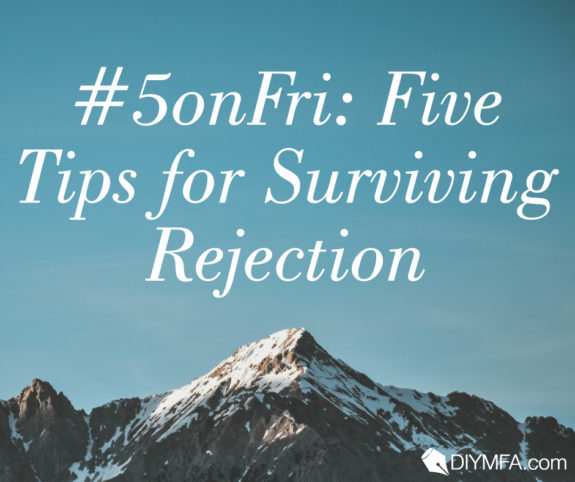Rejection. Nobody likes it—most writers experience it. The rejection tallies of famous books are something of a Holy Grail for writers:
- J.K. Rowling’s Harry Potter and the Philosopher’s Stone was rejected 14 times
- Margaret Mitchell’s Gone With The Wind was rejected 38 times
- George Orwell’s Animal Farm was rejected because “It is impossible to sell animal stories in the USA”
Considering the quality of these works and the millions of readers around the world who love them, their rejection was ridiculous. At the time though, each author had to survive rejection in order to present his or her work to the world—you must too.
My debut novel was rejected thirty three times by a combination of agents and editors before a publisher offered a contract—I know something about surviving rejection. Here are my five top tips for survival:
1) Stick with it
Sticking with trying to publish long enough to figure out how to succeed, while writing —these were both my top challenges and keys to my success. Here’s how: take a 100th hard look at what you’ve written and revise—you’ll find something to improve, always; write something new; build your author’s platform—you’re here in the DIYMFA website, author platform-building is central!
Network: attend writer’s conferences and talk to the conference speakers, pitch to agents—ask for their advice about submitting your work successfully—you’ll never have a better opportunity to ask the experts. If they like your pitch, move fast with your submission and send exactly what’s asked for—no more, no less.
Rejection stings—there’s no question. The silence that often follows submissions is worse. Open up your laptop and keep working. Right this minute you’re engaged in a website that offers a treasure trove of help, understanding, instruction, and support—explore all that DIYMFA has to offer—it will help your work in myriad ways.
2) And Still She Persisted!
Yes, you must persist, but with your eyes wide open. Research the publishing houses and agencies that best suit your work (and do create a mix of agents and editors for your submissions). Your style and genre vs. their list, the match between what they are looking for and your work—all must align. The information is available on the house or agency website. Consult websites such as Writer’s Digest, Poets & Writers, and your home away from home, DIYMFA. Some agencies reject at a higher rate than others—their rejection rates impact your chances— check out Query Tracker for all things submission related.
When you find “it does not suit my list” in rejection emails, it really might mean you chose the wrong agent or publisher for your work. Keep going, but keep your mind open: if the rejections pile up, ask yourself what’s wrong—stop burning your submission bridges until you do.
3) Don’t Put Your Head in the Sand
Find out what’s wrong. Who has read your work? If you’re sticking with family and friends, book clubs of neighbors and friends, or even writer’s groups, you may not learn what to do to avoid more rejection—your beta readers may not know how to help. Reach out to communities of writers and professionals. DIYMFA and all the team’s resources are right here. Take advantage of their offers of critique. Go to the website of a writer you like—one who writes in your genre—and see if she works as a freelance editor (many do). Trust her to review your manuscript, synopsis, query, and pitch—get her opinion on what’s holding you back. Criticism in a rejection from an agent or editor is rare but it’s like gold—mine it. Revise and rewrite, and ask a pro to review it again. Repeat.
4) It’s okay to sit in your car and cry
Irish golfer Shane Lowry won the 2019 British Open this summer. He not only won it, he blew the doors off of it. In previous years, he failed to even make the cut—essentially, he was rejected by the British Open after the first of three rounds—not once, but four times. After one of those dismissals, he sat in his car and cried. Shane’s a big bloke with a big red beard. After a good cry, he got back on the golf course and worked to perfect his game, and he hired a new caddie, an expert golfer, someone he trusted to help.
You’re only human, there will be bad days. It’s okay to release the stress with a good cry, or any healthy way you like. Take a walk to clear your mind, fill your lungs. Do a little yoga, stretch your neck and back—they take a beating while you sit and write.
5) Take A Deep Breath—Exhale
Walk the dog. Invite your spouse out to dinner. Take the kids to an ice cream parlor. Spring a surprise lunch on your mother. Day after day, you may appear to all of them as a black cloud behind a computer, and while you owe them a nice change—especially if you can only write in the evenings or on the weekends—you owe yourself one too. You’re trying to do one of the hardest things on earth—breaking through the wall from unpublished to published—give yourself and those around you some R&R, give yourself a break, and like Shane Lowry, go back to perfecting your game refreshed. Repeat.
Rejection number 28 was the nicest one I received: the editor loved my prose, but my novel did not fit her list, and it was the list of my dream publisher. Double heartbreak. Full disclosure though, around rejection number 31 I started to feel like I should give up. I felt silly continuing. I’d followed all of the tips above—several very late in the process, but I’d done all of them, and more than once—and I felt like giving up. It was a dangerous point in the process. I did not, I persisted, and as with all things worth doing, that’s key.
You likely have tips in addition to the five above, ones that got you through rejection—or are getting you through now—please share them, and best of luck!

Constance Emmett’s debut historical/LGBT+novel, Heroine Of Her Own Life, published by Next Chapter, begins shipping at the end of August. She writes in an aerie-like office in the beautiful foothills of the Massachusetts Berkshires. Her non-fiction is posted on her blog, or connect with her on Twitter @ConstanceEmmett, Facebook, or Instagram.







